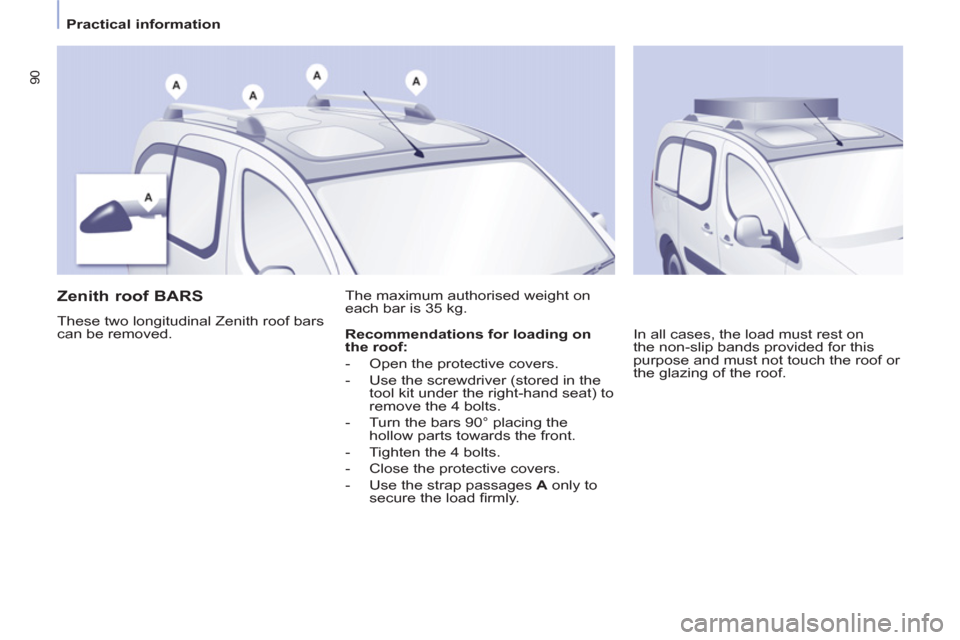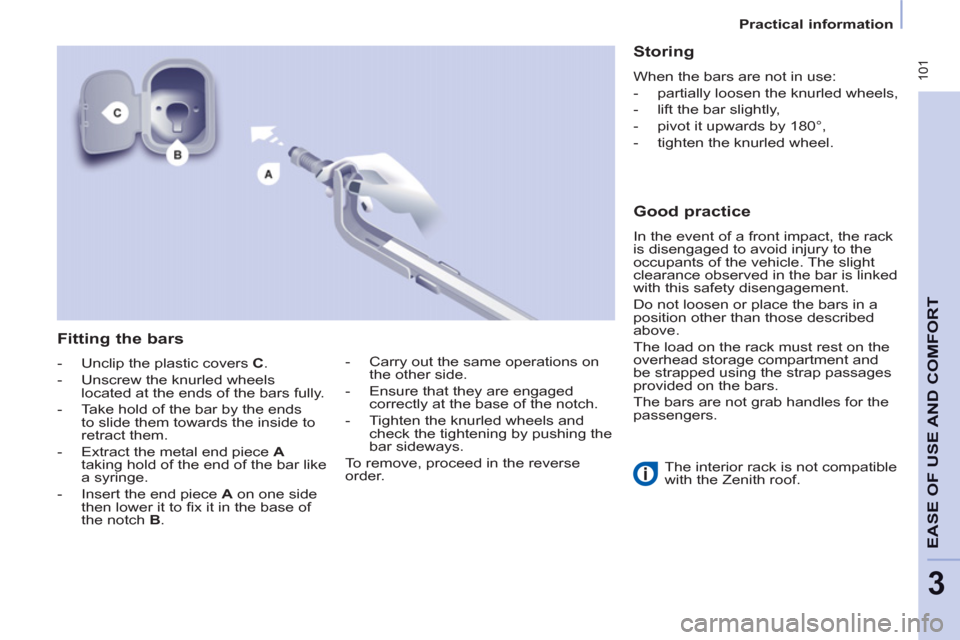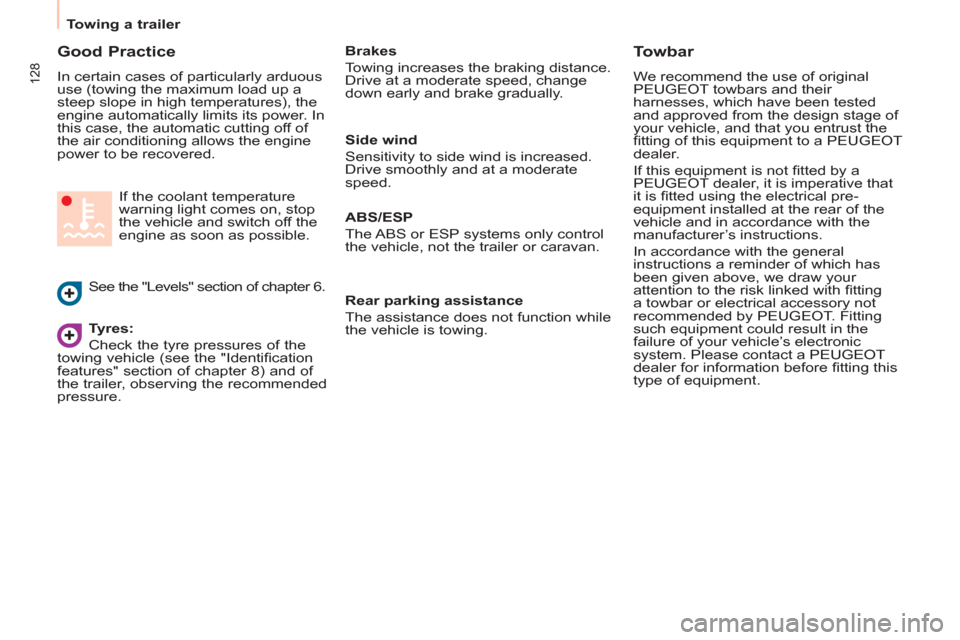2011 Peugeot Partner Tepee tow bar
[x] Cancel search: tow barPage 92 of 232

90
Practical information
Zenith roof BARS
These two longitudinal Zenith roof bars
can be removed. The maximum authorised weight on
each bar is 35 kg.
In all cases, the load must rest on
the non-slip bands provided for this
purpose and must not touch the roof or
the glazing of the roof.
Recommendations for loading on
the roof:
- Open the protective covers.
- Use the screwdriver (stored in the
tool kit under the right-hand seat) to
remove the 4 bolts.
- Turn the bars 90° placing the
hollow parts towards the front.
- Tighten the 4 bolts.
- Close the protective covers.
- Use the strap passages A only to
secure the load fi rmly.
Page 97 of 232

95
EASE OF USE AND COMFOR
T
3
Practical information
12 Volt socket (120 W Max)
It is advisable to limit the use of this
socket to avoid discharging the battery.
Protective net
Open the cover located in the hook
support.
Fix the top of the net in the notches,
having fi rst turned the bar 1/4 of a turn.
Ensure that the end of the bar engages
correctly in the metal part of its
location.
Fix the straps in the locations provided
on the fl oor.
Tighten the net using the straps.
Stowing rings
Use these rings to secure loads on the
fl oor.
Page 103 of 232

101
EASE OF USE AND COMFOR
T
3
Practical information
The interior rack is not compatible
with the Zenith roof.
Fitting the bars
- Unclip the plastic covers C .
- Unscrew the knurled wheels
located at the ends of the bars fully.
- Take hold of the bar by the ends
to slide them towards the inside to
retract them.
- Extract the metal end piece A
taking hold of the end of the bar like
a syringe.
- Insert the end piece A on one side
then lower it to fi x it in the base of
the notch B .
Storing
When the bars are not in use:
- partially loosen the knurled wheels,
- lift the bar slightly,
- pivot it upwards by 180°,
- tighten the knurled wheel.
Good practice
In the event of a front impact, the rack
is disengaged to avoid injury to the
occupants of the vehicle. The slight
clearance observed in the bar is linked
with this safety disengagement.
Do not loosen or place the bars in a
position other than those described
above.
The load on the rack must rest on the
overhead storage compartment and
be strapped using the strap passages
provided on the bars.
The bars are not grab handles for the
passengers.
- Carry out the same operations on
the other side.
- Ensure that they are engaged
correctly at the base of the notch.
- Tighten the knurled wheels and
check the tightening by pushing the
bar sideways.
To remove, proceed in the reverse
order.
Page 109 of 232

107
Parking sensors
SAFETY
4
Activation/Deactivation
Operating fault
In the event of an operating fault, whenreverse gear is engaged the diode on
the button comes on, accompanied
b
y an audible signal and a message on the display. Consult a PEUGEOTdealer.
Good practice
In bad weather or in winter, ensure that
the sensors are not covered with mud,
i
ce or snow.
The s
ystem will be deactivated
automatically if a trailer is being towedor if a bicycle carrier is fi tted (vehiclefi tted with a towbar or bicycle carrier recommended by PEUGEOT ).
The parkin
g assistance cannot, in
any circumstances, take the place of the vigilance and responsibility of
the driver. Y
ou can activate or deactivate
the system by pressing thisbutton.
Th
e activation or deactivation of the system is stored when
the vehicle stops.
Page 130 of 232

128
Towing a trailer
Good Practice
In certain cases of particularly arduous
use (towing the maximum load up a
steep slope in high temperatures), the
engine automatically limits its power. In
this case, the automatic cutting off of
the air conditioning allows the engine
power to be recovered.
Tyres:
Check the tyre pressures of the
towing vehicle (see the "Identifi cation
features" section of chapter 8) and of
the trailer, observing the recommended
pressure. See the "Levels" section of chapter 6. If the coolant temperature
warning light comes on, stop
the vehicle and switch off the
engine as soon as possible.
Brakes
Towing increases the braking distance.
Drive at a moderate speed, change
down early and brake gradually.
Towbar
We recommend the use of original
PEUGEOT towbars and their
harnesses, which have been tested
and approved from the design stage of
your vehicle, and that you entrust the
fi tting of this equipment to a PEUGEOT
dealer.
If this equipment is not fi tted by a
PEUGEOT dealer, it is imperative that
it is fi tted using the electrical pre-
equipment installed at the rear of the
vehicle and in accordance with the
manufacturer’s instructions.
In accordance with the general
instructions a reminder of which has
been given above, we draw your
attention to the risk linked with fi tting
a towbar or electrical accessory not
recommended by PEUGEOT. Fitting
such equipment could result in the
failure of your vehicle’s electronic
system. Please contact a PEUGEOT
dealer for information before fi tting this
type of equipment.
Side wind
Sensitivity to side wind is increased.
Drive smoothly and at a moderate
speed.
ABS/ESP
The ABS or ESP systems only control
the vehicle, not the trailer or caravan.
Rear parking assistance
The assistance does not function while
the vehicle is towing.
Page 145 of 232

143
QUICK HEL
P
7
Changing a wheel
1. PARKING THE VEHICLE
- Tthe occupants must get out of the
vehicle and wait in a safe location.
- If possible, park the vehicle on level,
stable and non-slippery ground.
- Apply the parking brake, switch
off the ignition and engage fi rst or
reverse gear.
- If available, place a chock under
the wheel diagonally opposite the
one to be changed.
If the vehicle is fi tted with a towbar,
it is sometimes necessary to raise
the vehicle slightly to make it easier
to remove the spare wheel from its
carrier.
On certain types of ground and/or
if considerable loads are being
transported, call a PEUGEOT dealer.
CHANGING A WHEEL
2. TOOLS
- The tools are stowed in a storage
compartment located under the
front seat. If necessary, move the
seat forward to access the storage
compartment from the rear.
- Unscrew the nut then take out the
jack and the wheelbrace.
1.
Wheelbrace.
2.
Jack.
3.
Alloy wheel embellisher remover.
4.
Chock.
The jack and the tool kit are specifi c to
your vehicle. Do not use them for other
purposes.
Page 160 of 232

158
Having your vehicle towed
Without lifting (4 wheels on
the road)
You should always use a towbar.
BEING TOWED
The towing eye is stored in the tool kit,
located under the right-hand seat.
From the front
- Unclip the cover by pressing the
bottom part.
- Screw in the removable towing eye
until it locks.
From the rear
- Unclip the cover using a coin or the
fl at part of the towing eye,
- Screw in the removable towing eye
until it locks.
When towing with the engine
switched off, there is no braking or
steering assistance.
Lifting (2 wheels on the road
only)
It is preferable to raise the vehicle
using professional lifting equipment.
Vehicles fitted with a manual
gearbox (diesel version)
In the case of vehicles fi tted with a
manual gearbox, the gear lever must
be in the neutral position, failure to
observe this special condition may
result in damage to certain braking
components and the absence of
braking assistance when the engine is
started again.
Page 225 of 232

167
Exterior
VISUAL SEARCH
10
EXTERIOR
Remote control 17-18
Changing the battery,
reinitialisation 18
Key 17
Starting 46
Hill start assist 47
Central locking/unlocking 17, 26
Filler cap, fuel tank 139
Fuel cut-off, Diesel priming 140
Wiper blade 157
Door mirrors 102
Side repeaters 150
Front lamps, foglamps, direction
indicators 48-49, 149-150
Headlamp beam height
adjustment 50
Changing front bulbs 148, 149-150
Headlamp wash 52, 136
Snow cover 147
Front doors 20
Sliding side doors 20-21
Key 17
Opening the bonnet 132
Child lock 126
Towing, lifting 127-128, 158
Towbar 127-128
Parking sesnsors 106-107
Rear roof fl ap 25
Emergency control 22
Spare wheel, jack,
changing a wheel, tools 143-147
Temporary puncture repair kit 142
Infl ation, pressures 165
Zenith roof 86
Roof bars 90, 91
Rear lamps,
direction indicators 48-49, 151
3rd brake lamp 152
Changing rear bulbs 148, 151
Doors, tailgate 22-24
Accessories 129
Number plate lamp 152
Dimensions 160-163
Brakes, pads 105, 137
Emergency braking 108
ABS, EBFD 108
ASR, ESP 109
"Grip control" 110
Tyres, pressures 165
Tyre under-infl ation detection 36